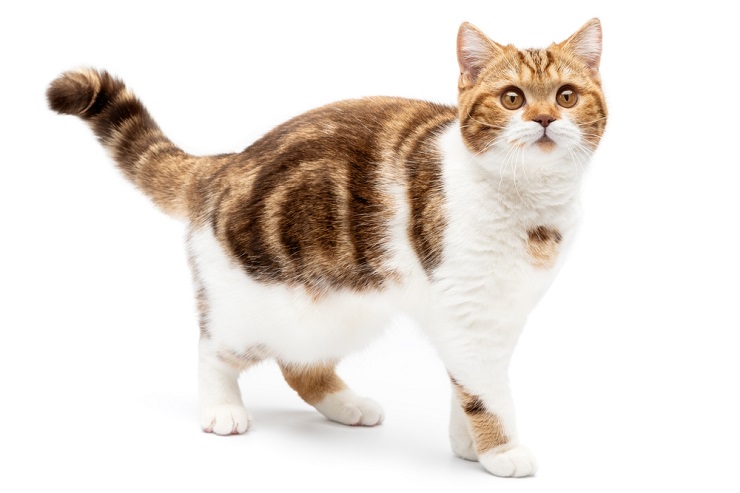
Having a baby is both an exciting and a worrisome time, but as with all change, prior consideration and preparation can make the difference between a stressful or a peaceful time for you, your infant and your cat.
Some cats won’t bat an eyelid at the change. Social and confident felines may show interest in the baby and his/her toys, while the timid and sensitive cats, may find the entire experience extremely stressful with numerous felines displaying both physical and behavioural signs of stress.
As the toddler grows up and becomes mobile, certain owners’ worries will shift to how the cat will behave towards the baby and the other way around.
Fortunately, with sensible planning discussed in this article, cats and babies can live together amicably and safely, often forming lifelong friendships with each other.
How To Prepare Before Baby Arrives

Babies and baby supplies have a unique smell, allow your cat to explore novel items in preparation for the baby’s arrival.
Below are 10 helpful tips that parents can make to prepare the cat to cope with a life-changing event of a newborn
1. Make Gradual Changes To The Home

Cats are creatures of habit with their main attachment to their physical environment rather than the humans within. Ensure that any changes made to the home like re-organisation or re-decoration and nursery construction occur in a gradual manner, months in advance.
2. Set Up The Nursery And Let Your Cat Tour It

Set up the nursery with modern furniture at least a month before your newborn’s arrival. Allow your cat to investigate and accept these changes to the room as you progress, helping your cat adjust slowly.
3. Prepare Your Cat For New Smells

Babies and baby supplies have a unique smell, allow your cat to explore novel items in preparation for the baby’s arrival. Help them accept new item smells by rubbing a cloth on the cat’s cheeks then rub this cloth on the most recent items to make it smell like part of the house through facial pheromones transfer, this will encourage your cat to feel safe and secure.
Furthermore, to get your cat accustomed to baby smells, start applying the baby powder and baby lotion on your hands weeks in advance, this could help your cat associate the new smell with a familiar scent to yours.
4. Help Your Cat Adjust To New Schedules

To minimise disruption to your cat’s routine additionally to help adjust to new schedules (feeding times, caregiver changes, reduction in interaction), make slow changes early on. For instance, you may want to change who feeds the cat before the baby’s arrival since it’s unlikely a new mum will be able to continue getting up early mornings after birth.
5. Ensure Your Cat Has Safe Places To Hide

Ensure your moggy has plenty of places to feel safe out of the toddler’s reach. Cardboard boxes, shelves and igloo beds are valuable as hiding spots.
6. Let Your Cat Hear The Sounds Of A Baby Crying Well In Advance

Prepare your cat to hear sounds of a baby’s cry by playing this audio clip weeks before the due date. Initially play it at a faint sound and if your cat doesn’t show interest, steadily increase the volume. You want to assist your cat learn that a baby’s cry is nothing to be concerned about since it will be a common sound in the coming months.
7. Train Your Cat To Go A Sanctuary Space

Train your cat to be comfortable and relaxed in a sanctuary room with all their important resources provided within to ensure they have a safe and quiet retreat; a spare office or bedroom works well.
By modifying the environment and adding baby gates you provide safe place out of reach of children while the cat feels safe watching from the far.
8. Enrich Your Home And Consider Use Of A Feliway Diffuser

Equip and enrich your home with multiple opportunities for the cat to play, scratch, hide and perch to help your cat cope with stress and reduce boredom when mum and bub are bonding. Moreover, consider plugging a Feliway Diffuser in or near the nursery a week prior the due date.
9. Train Your Cat To Go To A Mat Or Blanket On Cue

Training your cat to go to a Mat on cue through positive reinforcement can help parents separate the cat without conflict or frustration. The mat or blanket can be placed strategically so the parent’s body is between the feline and the child while building a positive emotional association with the nearby infant.
10. Bring Home A Sleepsuit Or The Babies Blanket From The Hospital

Once the infant is born, while you’re in hospital, ask a family member to take a sleepsuit or blanket that your new baby has worn and place it in the cat’s prominent area or the sanctuary room to help your cat sniff and develop positive association with the scent which will feel less daunting once the baby arrives home.
How To Introduce Baby And Cat
Similar to cat-cat or cat-dog introductions, it’s vital baby and kitty introductions are done gradually at your cat’s pace. Cats need to feel in control of the interaction with the ability to escape or observe from the far.
1. Greet Your Cat Alone Upon Arrival From The Hospital
Once you return home with your baby, initially greet your cat without the baby to re-form your bond with your kitty.
2. Hold Your Baby And Allow Your Cat To Smell And Investigate It In Your Arms
When baby, kitty and mom are relaxed, find a quiet room, introduce your baby and let your cat smell the newborn to get acquainted with the novel smell and noise, remain calm at all times whilst reward your moggy with praise and treats.
3. Form Positive Associations And Encourage Gentle Interactions From Day One
Both children, as well as cats, possess individual, unique traits, therefore introductions should be tailored to those concerned starting from day one.
Children learn from consistent repetition and positive reinforcement, keep interactions short so it’s not overwhelming for the kid or the cat. Giving your cat tasty nibbles while you’re feeding your newborn is also an excellent way to form positive associations between the cat and the neonatal.
4. Supervise All Interactions Between Your Infant And Feline
Never leave your infant and feline unsupervised within the home no matter how placid your cat is. Install either a screen door to the nursery or place mesh on the crib to minimise soiling incidents if there’s no door to keep the cat out.
5. Shower Your Cat With Play, Brushing And Praise
It’s easy to overlook your cat’s needs when you’re tired, sleep deprived and strapped for time. Be available to interact plus bond with your feline daily through stroking, play-therapy, brushing with lots of praise.
Provide your kitty self-play toy options that imitate your individual cat’s prey preferences including puzzle feeders in an uninterrupted spot to promote foraging and feeding opportunities.
Also Read: The 10 Best Cat Slow Feeders & Puzzle Feeders
6. Don’t Punish Your Cat For Negative Behaviours
Please don’t punish your cat for any negative behaviours that your cat displays towards your toddler since it may reinforce emotional fear and heighten the intensity of this responses in the future.
Conclusion
Successful introductions and harmonious relationships aren’t based on luck. When parents take proactive steps to prepare as well as introduce cats and kids properly from the start, nurtures will have a content kitty and happy kids which in the long run will help children become compassionate and responsible grownups.
Frequently Asked Questions:
How can I get my cat to get along with my baby?
Set your cat for success by preparing them and also the home environment as early as possible. Parents should introduce progressively new baby paraphernalia and get the cat used to baby crying sounds to assist ease them into the change at the cat’s own pace. Once the baby arrives, introductions should be done in a quiet, controlled and above positive manner tailored to the individual cat and infant through gentle interactions.
How long does it take for a cat to get used to a baby?
Since each cat is an individual influenced by their genetics, temperament including previous experiences, how long an individual cat will get used to a baby will differ based on each individuals’ unique traits.
Is it safe to have cats around newborn babies?
Cats should always be supervised around newborn babies. Keep the baby’s room out of your cat’s reach, especially when your toddler is small. Place a net over a baby pram or bassinet to prevent the cat climbing inside, adhere to safety by washing your hands after carrying your cat or cleaning their litter box(s) and lastly apply monthly cat parasite prevention treatment.
Do cats get jealous of new babies?
I would like to reassure parents that cats are NOT jealous of babies. While some of the behaviours displayed in response to the baby’s arrival can come across as jealousy, cats aren’t capable of the emotional feeling of jealousy. The uniqueness of a baby’s sound, smell and sight can be unnerving for a cat who’s a creature of habit.
-
Care, I. C. (2020, September 01). Module 5 Creating a cat friendly home, Part 3.3 Babies, Children and cats. Advanced Feline Behaviour for Vet Profesisonals. UK. Retrieved January 21, 2022
-
CatCare. (2015). Cats & Babies. (I. C. Care, Compiler) UK. Retrieved January 22, 2022
-
Society, T. H. (2018). Bringing Home Baby for Cat Lovers. Canada: Toronto Humane Society. Retrieved January 24, 2022
-
Trevorrow, N. (2018). Introducing cats to babies and children. (C. Protection, Compiler) UK: CP Clinic. Retrieved January 16, 2022
-
Yuschak, S. (2019, June 01). Cats and kids: relationships aren’t born, they’re made. (F. Focus, Compiler) USA: International Society of Feline Medicine. Retrieved January 18, 2022







